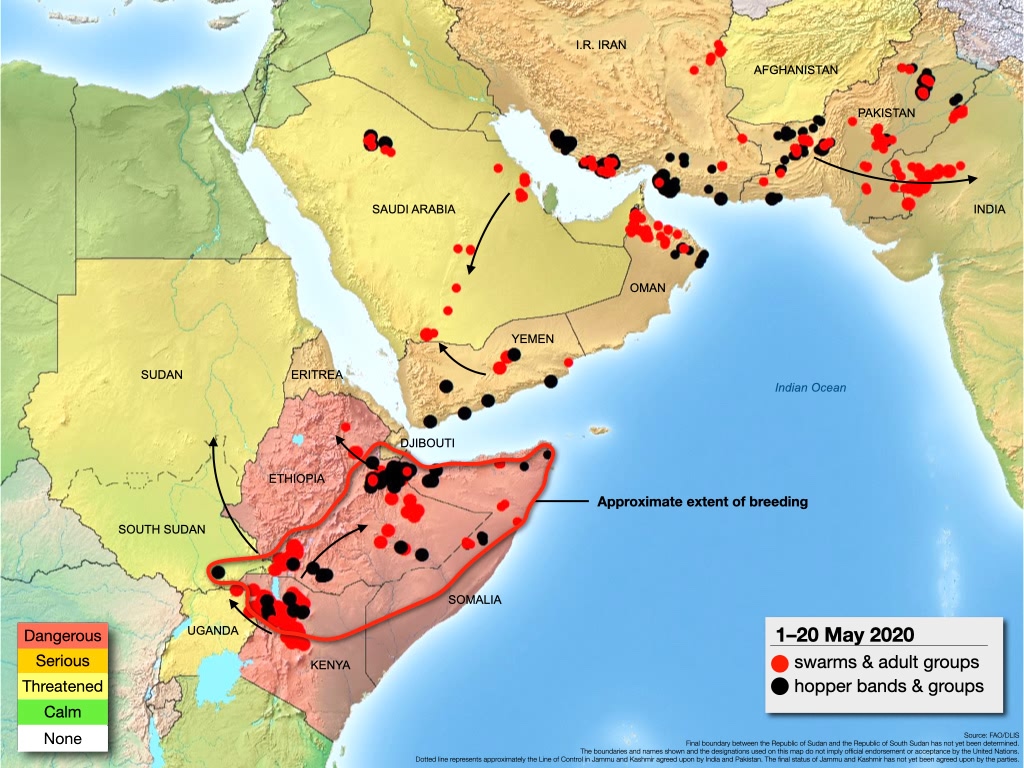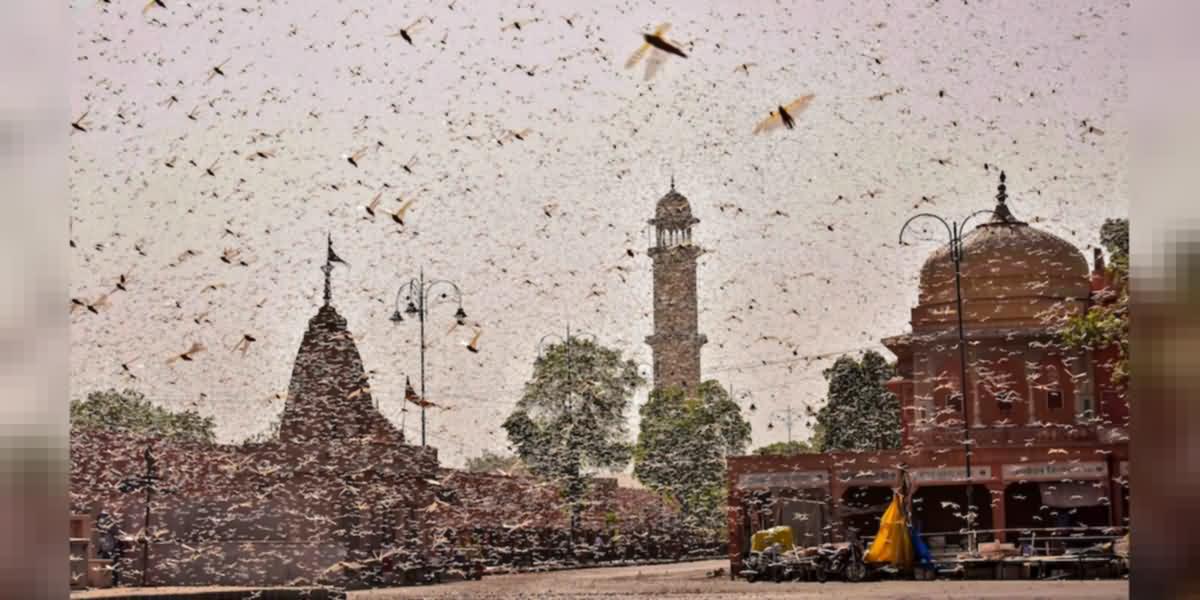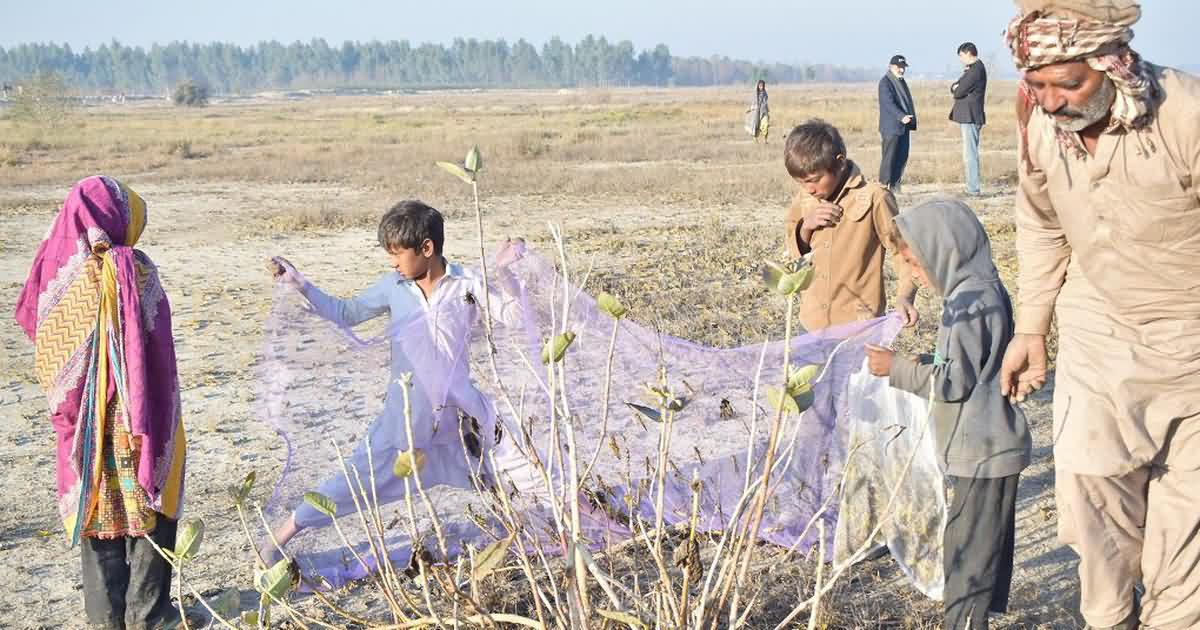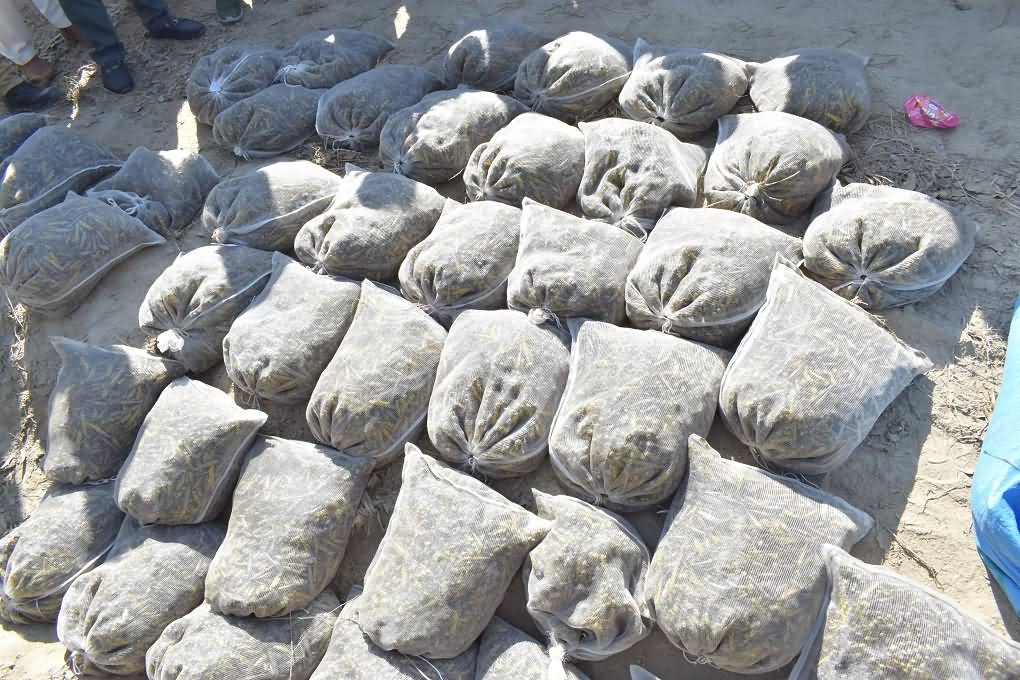कुक्कुट चारा (पोल्ट्री फीड) में टिड्डी प्लेग का उपयोग
Large swarms of desert locust (Schistocerca gregaria) threatened agriculture crops in most of the parts of world including India, this loom happened worst ever before in past two and half decades. “Locust feeding to poultry birds” is an innovative technique evolved in neighboring countries of India offers a way to amass the crop-destroying pests instead of using insecticides that harm people and the environment.
Huge swarms darkened the sky in recent days and it appears being overtaken by aliens. It was biggest blow upon poor farmers and rural communities who are already hit hard economically by COVID-19 pandemic.
Climate change has played a crucial role on the locust plague. It started after exceptional cyclonic rainfall moistened the “Empty Quarter” deserts of Saudi Arabia in 2019. The swarms were swept eastwards through Iran to Pakistan by seasonal winds.
After breeding in Pakistan’s eastern deserts, the locusts took to the air again in late winter. Currently, another generation has hatched, and entered into India. India’s western provinces were first overwhelmed by these huge swarms. Fresh swarms are just beginning to take to air and are expected to grow until mid-summer.
Locust’s origin and migration
A locust is a large, mainly tropical, grasshopper with powers of flight and it migrates in vast swarms which cause extensive damage to crops and other vegetations. The desert locust is considered as most destructive migratory pest in the world and a single swarm covering one square kilometer, can contain up to 80-100 million locust community.
Pink immature adults (the lifecycle of a locust goes from eggs, to hoppers, to very active pink immature adults, to yellow mature adults which lay eggs) fly high and cover long distances (Mohamed Shaluf, 2007) during day hours along with the westerly winds. Most of these pink immature adults settle on trees during night, and fly during the daytime.
The immature locust is very active during day time and their mobility makes it difficult to control. The huge swarm takes four to five days to move from one location to another. It was noted that the outbreak started after warm waters in the western Indian Ocean in late 2019 fuelled with heavy amounts of rains over east Africa and the Arabian Peninsula.
The phenomena of warm water caused, called as Indian Ocean Dipole with warmer than usual waters to its west, and cooler waters to its east (Webster, 1999). Rising temperatures due to global warming amplified the dipole and made the western Indian Ocean particularly warm. Heavy rain triggers the growth of vegetation in arid areas where desert locusts can then grow and breed.
These locusts which migrated to India early this year might have found greener pastures. As, the pre-monsoon rains during March-May were in excess over north India this year, it is necessary to control swarms before onset of monsoons.

Plate 01: Spread of locust Swarms of locust (Source: mongabay-India)
The Upcoming threat and Imminent Danger
Usually, the locust swarms enter in the desert area of India through Pakistan for summer breeding in the month of June/July with the advent of monsoon. This year incursions of locust hoppers and pink swarms have been reported much earlier because of presence of residual population of locust, which couldn't control last season.
There will be no impact on rabi (winter) season crops like wheat, pulses and oilseeds as most of them are harvested by now. Swarms have already attacked crops in Rajasthan and Madhya Pradesh, and are affecting orange cultivation in Nagpur.
Starting June, infestations in India and Pakistan could be supplemented by other swarms coming from East Africa, northern Somalia. In present situations it is expected that towards the end of May and in June and July, high level migration is expected and most recently, the locusts have entered in Katol and Parseoni regions of Nagpur district of Maharashtra, with eyes set on neighboring Bhandara district.
In addition to this, there are active swarms of immature locusts in 8 districts in Rajasthan (Barmer, Jodhpur, Nagaur, Bikaner, Ganganagar, Hanumangarh, Sikar and Jaipur) and 7 districts in Madhya Pradesh (Satna, Gwalior, Seedhi, Rajgarh, Baitul, Devas, Agar Malwa) has been reported.

Plate 02: Swarms of Locust over the Jaipur city in Rajasthan (Source: thewire.in)
Locust use in Poultry
An innovative project and a sustainable solution has been initiated using locust as poultry bird feed and successfully demonstrated in Pakistan’s Okara district. It provides income to the farmers, locusts that are turned into high-protein chicken feed.
The motto “Eat the locusts before they eat the crop” has been much popular among rural small scale poultry farmers of Pakistan and Iran (FAO 2020) and locust has been used as poultry feed in Yeman in 2019. They set up a three-day trial project in the Pepli Pahar Forest in Depalpur, where huge swarms of adult locusts were reported in mid-February 2020.
The forest area was chosen as it was less likely to be contaminated by insecticide. Using the slogan, “Catch locusts Earn money Save crops”, project offered farmers to earn 20 Pakistani rupees (USD 0.12) per kilogram of locusts.

Plate 03: Locusts collection using nets in Okara, Pakistan (image by: Muhammad Khurshid)
As, locusts are rest during nights in clusters on trees and open ground even without dense vegetation, remain motionless till sunrise the next day, they are easy to catch at night.
The community’s locust haul averaged seven tonnes a night. The project team weighed the locusts and sold them to nearby plants making chicken feed.
Farmers are earning up to 20,000 Pakistani rupees (USD 125) per person/ night. People were enthusiastic day by bay to trap the swarm of locust for the money sake.

Plate 04: Locusts in huge bags for selling collected by communities in Okara district (image by: Muhammad Khurshid)
Feeding the bug based feed to broiler chickens in a five-week study indicated that it there was no issue with the feed made from these locusts. Moreover, the bug based feed enhance the growth of chickens and all nutritional aspects came out positive.
And farmers who cannot afford insecticides, will have income of locust trapping for bird feed, eliminating harmful effect of insecticides and their biological values remained high.
The bug based feed have good potential for use in fish, poultry and even dairy feed (Gibreil and Idris, 1997). This is an estimated 1.5 billion chickens being raised and plus innumerable fish farms all of which could potentially buy high protein locust meal (Khan, 2020).
Lesson learned
Okara’s example may be useful for others. There is usually some locust activity in western Rajasthan and Gujarat most years. But current year the spread has extended to eastern Rajasthan, and locust swarms have been seen in Maharashtra, Uttar Pradesh and Madhya Pradesh.
An unusually wet late winter season has laid the pathway for the locusts to spread, though a heat wave in central India may provide some relief.
References
FAO, 2020.Food and Agriculture Organization of United Nations. http://www.fao.org
Gibreil, S. and Idris, A. A. 1997. Utilization of locust meal in poultry feeds. JONARES, 1, 19-23.
Locust plagues and upsurges. 2017. Directorate of plant protection, quarantine & storage. Government of India.
Mohamed Shaluf, I. (2007). An overview on disasters. Disaster Prev. Manag. 16, 687–703.
Rina Saeed Khan. May 28, 2020. Pakistan turns locust threat into chicken feed. thirdpole.net.
Rituraj Tiwari. May 29, 2020. Government steps up measures to control locust. The economic times: Agriculture. India.
The week Magazine. 2020. Explainer: India's 'worst' locust plague, and why it needs to be controlled before monsoon. https://www.theweek.in
Webster, P. J., Moore, A. M., Loschnigg, J. P., Leben, R.P. 1999. Coupled ocean–atmosphere dynamics in the Indian Ocean during 1997–98. Letters to Nature. 401 (6751): 356–360.
Authors:
Brij B. Pandey1 and Ratnakumar Pasala2
1 Indira Gandhi Agricultural University, Raipur, 492012, Chhattisgarh, India
2ICAR-Indian Institute of Oilseeds Research, Rajendranagar, Hyderabad, 500030, Telangana, India
Email:
